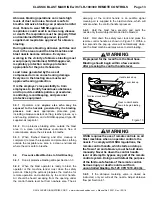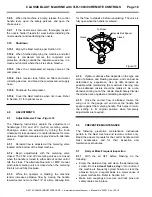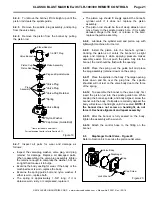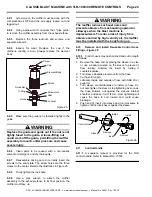
CLASSIC BLAST MACHINE with TLR-100/300 REMOTE CONTROLS
Page 10
© 2018 CLEMCO INDUSTRIES CORP.
www.clemcoindustries.com
Manual No. 22501, Rev. I 02/18
3.0 OPERATION
3.1
Transporting and Moving
WARNING
Failure to observe the following warnings
before transporting or moving a blast machine
could result in serious injury or death:
Always empty the blast machine before
lifting or hoisting.
Never hoist the machine by the handle or
piping, or with a sling through the handle
or piping.
Always use lift equipment that is rated
higher than the weight of the machine and
accessories.
When transporting a machine on a pallet,
always securely attach the machine to a
sturdy pallet.
Always securely anchor the machine to the
transport vehicle.
Anyone using material handling equipment
to move, transport, or lift the machine must
be experienced, able to recognize and avoid
hazards associated with handling this type
of machinery, and able to safely operate the
equipment.
3.1.1
Transporting a Blast Machine
3.1.1.1
Always empty the machine before transporting.
Transporting a machine containing abrasive may
increase the weight to an unsafe handling limit and could
cause abrasive to settle in the piping.
3.1.2
Moving a Blast Machine
WARNING
Do not manually move the machine on an
incline, or on a slippery or irregular surface
that can cause the operator to slip or lose
balance. Sudden weight shifts when the
machine is tilted on an incline, and slipping or
tripping while moving the machine will cause
the operator to lose control of the machine,
causing severe injury and property damage.
WARNING
Never attempt to manually move a blast
machine when it contains abrasive. An empty
machine may be moved manually in a forward
direction on level flat surfaces.
3.1.2.1
An empty machine may be moved manually on
level flat surfaces by at least two people.
3.1.2.2
Slide the machine by pushing it in a forward
direction toward the wheels. To avoid tripping hazards
that may be out of view, do not back-up while moving
the machine.
3.1.2.3
The Clemco Mule (Stock No. 20331) is designed
to facilitate moving empty 2 cuft to 6 cuft capacity
Clemco blast machines. Contact a Clemco Distributor for
additional information.
3.2
Setup for Operation
3.2.1
Locate the compressor upwind from the blasting
operation to prevent contaminated air from entering the
compressor intake.
3.2.2
Attach an air line from the compressor to the air-
supply hose connector installed on the blast machine inlet.
For best blasting performance, use the minimum
recommended hose size as noted in Section 2.5, Refer to
the compressed-air and abrasive consumption table in
Figure 10 for approximate air consumption.
3.2.3
Make sure the coupling gaskets are in place and
in good condition before connecting the blast hose to the
quick coupling on the blast machine.
NOTE: Spring-
lock pins are affixed to nylon couplings. When
connecting two nylon couplings together, make sure
the coupling spring-lock pins are at 180 degrees,
(Pins should enter the open hole of the adjoining
coupling.) The lock pins prevent accidental separation of
hose couplings during blasting. When connecting a nylon
coupling to a metal coupling, one affixed spring-lock pin
and one detached lock-pin, as shown in Section 8.2 is
used. When connecting two metal couplings together, use
two safety lock pins.
3.2.4
Make sure that all blast-hose couplings and
compressed-air supply hose connections are secured
with safety lock pins to lock the couplings together and
prevent accidental separation while under pressure, and
with safety cables to prevent hose from whipping should
separation occur. Lock pins and safety cables are listed
in Section 8.2.












































